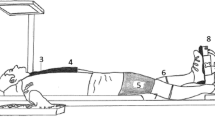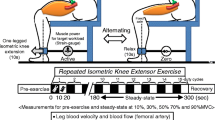Summary
The effects of muscle contraction frequency on blood flow to the calf muscle (Q calf) were studied in six female subjects, who performed dynamic plantar flexions at frequencies of 20, 40, 60, 80 and 100 contractions · min−1, in a supine position. TheQ calf measured by a mercury-in-rubber strain gauge plethysmograph, increased as contraction frequency increased and reached a peak at 60–80 contractions · min−1. After 100 plantar flexions at 60 contractions · min−1, the meanQ calf was 30.95 (SEM 4.52) ml · 100 ml−1 · min−1. At 100 contractions · min−1, however, it decreased significantly compared with that at 60 contractions · min−1 at a specified time (2 min or exhaustion) or after a fixed amount of work (100 contractions). The contraction frequency at whichQ calf reached a peak depended on the duration of exercise. The heart rate showed its highest mean value at 60 contractions · min−1 and decreased significantly at 100 contractions · min−1. The mean blood pressure was lower at 100 contractions · min−1 than at 60 contractions · min−1. The relaxation period between contractions, measured by recording the electromyogram from the gastrocnemius muscles, shortened markedly as the frequency increased; the mean value at 100 contractions · min−1 was 0.14 (SEM 0.02) s, which corresponded to 35.7% of the contraction time. This shortened relaxation period between contractions should have led to the inhibition of exercise hyperaemia at the higher contraction frequencies.
Similar content being viewed by others
References
Barcroft H, Millen JLE (1939) The blood flow through muscle during sustained contraction. J Physiol 97:17–31
Barcroft H, Dornhorst AC (1949) The blood flow through the human calf during rhythmic exercise. J Physiol 109:402–411
Barnes WS (1980) The relationship between maximum isometric strength and intra-muscular circulatory occlusion. Ergonomics 23:351–357
Bonde-Petersen F, Robertson CH Jr (1981) Blood flow in “red” and “white” calf muscles in cats during isometric and isotonic exercise. Acta Physiol Scand 112: 243–251
Bonde-Petersen F, Mørk AL, Nielsen E (1975) Local muscle blood flow and sustained contractions of human arm and back muscles. Eur J Appl Physiol 345:43–50
Byström SE, Kilbom A (1990) Physiological response in the forearm during and after isometric intermittent handgrip. Eur J Appl Physiol 60:457–466
Citterio G, Agostoni E (1984) Selective activation of quadriceps muscle fibers according to bicycling rate. J Appl Physiol 57:371–379
Corcondilas A, Koroxenidis GT, Shepherd JT (1964) Effect of a brief contraction of forearm muscles on forearm blood flow. J Appl Physiol 19:142–146
Folkow B, Halicka HD (1968) A comparison between “red” and “white” muscle with respect to blood supply, capillary surface area and oxygen uptake during rest and exercise. Microvasc Res 1:1–14
Frisk-Holmberg M, Jorfeldt L, Juhlin-Dannfelt A, Karlsson J (1981) Leg blood flow during exercise in man in relation to muscle fiber composition. Acta Physiol Scand 112:339–342
Humphreys PW, Lind AR (1963) The blood flow through active and inactive muscles of the forearm during sustained handgrip contractions. J Physiol 166:120–135
Ingjer F (1979) Capillary supply and mitochondrial content of different skeletal muscle fiber types in untrained and endurance-trained men. A histochemical and ultrastructural study. Eur J Appl Physiol 40:197–209
Joyner MJ, Lennon RL, Wedel DJ, Rose SH, Shepherd JT (1990) Blood flow to contracting human muscles: influence of increased sympathetic activity. J Appl Physiol 68:1453–1457
Kagaya A (1989) The rate of peripheral circulatory adjustment at the onset of exercise. Jpn J Phys Fitness Sports Med 38:167–174
Laughlin MH, Armstrong RB (1982) Muscular blood flow distribution patterns as a function of running speed in rats. Am J Physiol 243 (Heart Circ Physiol 12): H296–H306
Laughlin MH, Korthus RJ, Sexton WL, Armstrong RB (1988) Regional muscle blood flow capacity and exercise hyperemia in high-intensity trained rats. J Appl Physiol 64:2420–2427
Lind AR, McNicol GW (1967) Local and central circulatory responses to sustained contractions and the effects of free or restricted arterial inflow on post-exercise hyperaemia. J Physiol 192:575–593
McKirnan MD, Gray CG, White FC (1989) Plateau in muscle blood flow during prolonged exercise in miniature swine. J Appl Physiol 66:2101–2108
Moritani T, Oddsson L, Thorstensson A (1990a) Electromyographic evidence of selective fatigue during the eccentric phase of stretch/shortening cycles in man. Eur J Appl Physiol 60:425–429
Moritani T, Oddsson L, Thorsensson A (1990b) Differences in modulation of the gastrocnemius and soleus H-reflexes during hopping in man. Acta Physiol Scand 138:575–576
Pendergast DR, Shindell D, Cerretelli P, Rennie DW (1980) Role of central and peripheral circulatory adjustment in oxygen transport at the onset of exercise. Int J Sports Med 1:160–170
Richardson D, Shewchuk R (1980) Effects of contraction force and frequency on postexercise hyperemia in human calf muscles. J Appl Physiol 49:649–654
Rodbard S, Pragay EB (1968) Contraction frequency, blood supply, and muscle pain. J Appl Physiol 24:142–145
Sadamoto T, Bonde-Petersen F, Suzuki Y (1983) Skeletal muscle tension, flow, pressure, and EMG during sustained isometric contractions in humans. Eur J Appl Physiol 51:395–408
Saito M, Mano T, Iwase S (1990) Changes in muscle sympathetic nerve activity and calf blood flow during static handgrip exercise. Eur J Appl Physiol 60:277–281
Seals DR (1989) Influence of muscle mass on sympathetic neural activation during isometric exercise. J Appl Physiol 67:1801–1806
Vøllestad NK, Wesche J, Sejersted OM (1990) Gradual increase in leg oxygen uptake during repeated submaximal contractions in humans. J Appl Physiol 68:1150–1156
Whitney RJ (1953) The measurement of volume changes in human limbs. J Physiol 121:1–27
Author information
Authors and Affiliations
Rights and permissions
About this article
Cite this article
Kagaya, A. Reduced exercise hyperaemia in calf muscles working at high contraction frequencies. Europ. J. Appl. Physiol. 64, 298–303 (1992). https://doi.org/10.1007/BF00636215
Accepted:
Issue Date:
DOI: https://doi.org/10.1007/BF00636215




